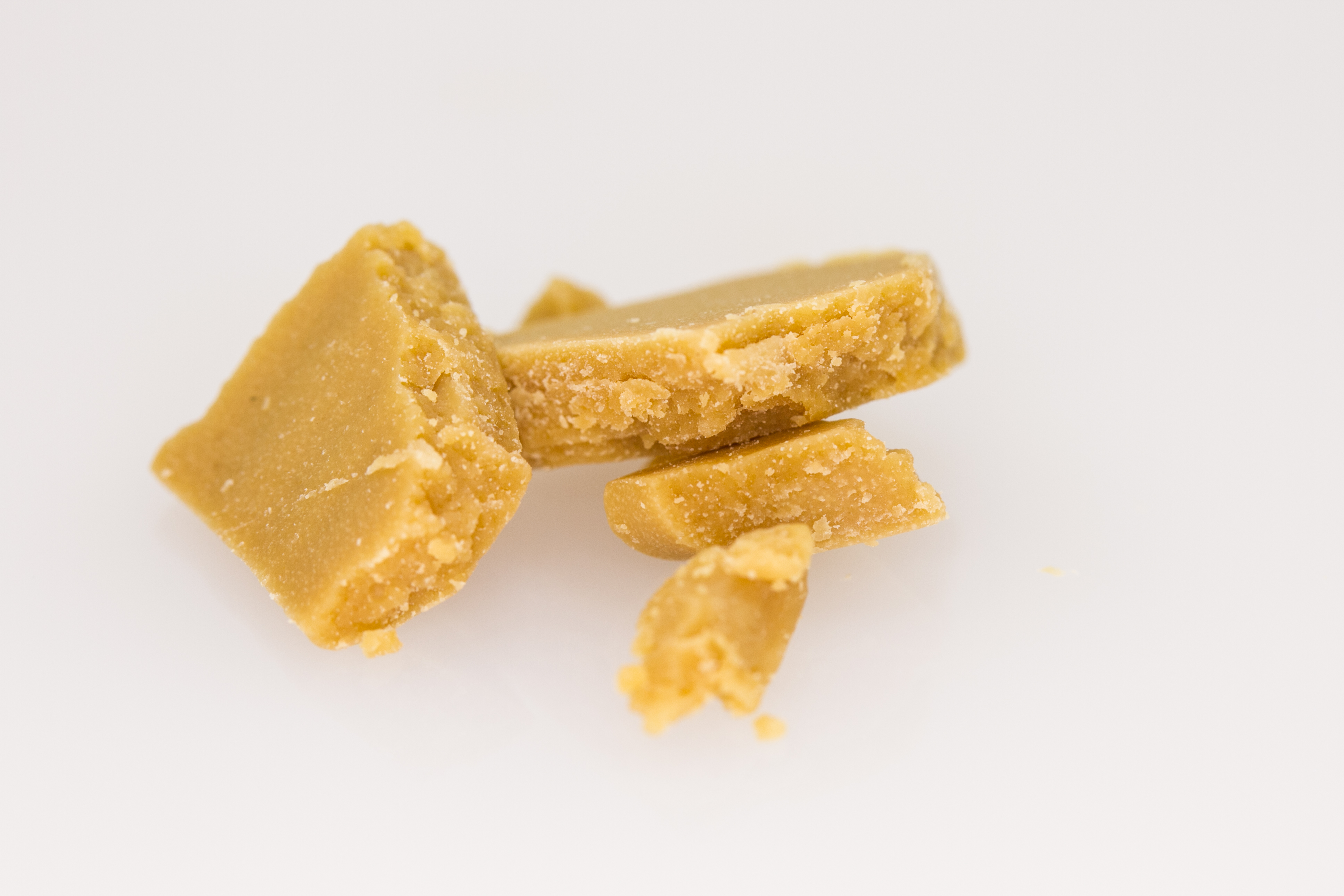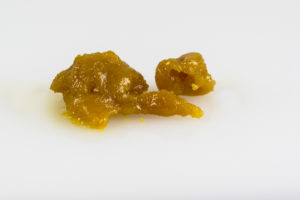
Concentrates made from cannabis have been around for a long time; yet lately, the term has become a bit enigmatic. Perhaps you have heard of wax or are familiar with hash. These are two forms of cannabis concentrate that have been extracted through different methods. While there are many aspects of cannabis that can be extracted, the most common elements are cannabinoids like THC and CBD. Concentrates are aptly named as they are more potent than smoking cannabis flower, making it ideal for those who need a fast acting, high dose treatment to alleviate their pain. To understand the nature of concentrates, we need a better understanding of how cannabis produces the medicines known as cannabinoids.
To the naked eye, a bud of cannabis appears to be covered in a blanket of crystals. These are actually mushroom like hairs called trichomes that are a defense mechanism of the plant. Trichomes are glands that produce an oil based resin that help protect the plant from possible sources of harm such as U.V. rays, insects, and molds. These resinous glands are where cannabinoids, terpenes, and flavonoids are produced, giving each strain its particular profile of effects and tastes. The trichomes of cannabis are the basis for all concentrates.
 Concentrates differ in how they are made but generally fall into two categories: concentrates extracted with a solvent and concentrates made using no solvent, or solventless. Depending on the extraction method, a concentrate will have differing amounts of cannabinoids, terpenes, shapes, and textures.
Concentrates differ in how they are made but generally fall into two categories: concentrates extracted with a solvent and concentrates made using no solvent, or solventless. Depending on the extraction method, a concentrate will have differing amounts of cannabinoids, terpenes, shapes, and textures.
When trichomes are knocked off and dried, they form a sticky, sand-like material known as kief or dry sift. For personal collection, there are grinders that have screens with holes small enough to catch and collect kief in a separate chamber. Kief can be used by itself, sprinkled in with other ground cannabis for greater potency or collected and pressed to make hash.
Hash can be made in several ways producing differing levels of potency and quality. Kief can be pressed together to make the simplest hash concentrate, often appearing as small green “pucks”. Another common form of hash comes from the build up of resin on a person’s finger tips while handling cannabis buds and leaves; this is referred to as finger hash. As the resinous trichomes are not water soluble, higher grades of hash are made using ice water and filtering the material through micron screens to collect the material. There are multiple screen sizes which the material is sifted through from largest to smallest. This gives superior hash qualities like bubble hash (that actually bubbles up when smoked) or full-melt hash (which contains only the trichome heads and completely disappears when smoked).
Like kief and hash, rosin is a solventless extract. Using a combination of heat and pressure, cannabis is pressed to extract a resin commonly called rosin. This concentrate can be made very simply with parchment paper and a hair straightener; however, most high grade rosins are made using a hydraulic or mechanical press capable of applying a great deal of pressure.
Utilizing botanical extractors, trichomes can be separated from cannabis by means of
supercritical fluid extraction. In a closed system, carbon dioxide (CO2) is compressed beyond its “critical point” allowing it to act like both a gas that diffuses through solids and a liquid that dissolves compounds. CO2 reaches this critical point at a low temperature allowing more terpenes to be saved in the process. After extraction, the pressure is lowered which allows the CO2 to evaporate. The most common way to use CO2 oil is in disposable vaporizer cartridges. Since the oil itself is rather thick, most CO2 oil in cartridges are mixed with propylene glycol or MCT oil to make it easier to vaporize.
One of most popular forms of cannabis concentrate is butane hash oil or BHO. This is one of the most potent extracts, so very little is needed to receive a high dose of medication. It is often referred to as “dabbing” because you need “just a dab” to get a great deal of cannabinoids at once. Extracts of BHO can seem tricky because they are called by many names depending on their consistency. One of the most common names for this extract is wax or crumble, originally so named as traditional wax has a tacky consistency and is golden yellow in color much like actual ear wax. Other common consistencies of BHO are the thin, glass-like shatter, the viscous-syrup like sap, and batter named for it’s cake batter like texture. This does not cover all the categories, but the differences are somewhat trivial as the consistency is more about personal preference and ease of use.
No matter the consistency, all BHO is made in a similar fashion. Cannabinoids and terpenes are extracted from cannabis using butane as the main solvent. Butane is highly flammable, and it can be very dangerous to those who are not intimately familiar with the process. After the extraction is complete, the butane is removed and the remaining compound must be purged of impurities, most often in a vacuum chamber. Without clear regulation, some provisioning centers may offer BHO that was not properly purged, leaving many toxic chemicals in the end product. Ask if a residual solvent test was performed when you get BHO to ensure you do not inhale anything hazardous. We recommend not consuming any BHO with more than 500 part per million total residual solvents.
 Full spectrum cannabis oil, better known as Rick Simpson oil or RSO, is a potent concentrate that is meant to be ingested. Originally made popular as part of a regimen to treat cancer, this high dose concentrate can range in potency and consistency depending on the source material. RSO is made using most of the cannabis plant including stems and leaves. This material is collected in a container with ethanol to extract cannabinoids as well as terpenes, flavonoids, and other plant matter. Once the ethanol is removed, the final product is a thick, dark oil that is typically tar-like in consistency. Since RSO is made to be potent, use extreme caution will administering a dose. For more information about dosing, read our article Are Medical Marijuana Edibles Right for You? RSO is not meant to be smoked or vaporized.
Full spectrum cannabis oil, better known as Rick Simpson oil or RSO, is a potent concentrate that is meant to be ingested. Originally made popular as part of a regimen to treat cancer, this high dose concentrate can range in potency and consistency depending on the source material. RSO is made using most of the cannabis plant including stems and leaves. This material is collected in a container with ethanol to extract cannabinoids as well as terpenes, flavonoids, and other plant matter. Once the ethanol is removed, the final product is a thick, dark oil that is typically tar-like in consistency. Since RSO is made to be potent, use extreme caution will administering a dose. For more information about dosing, read our article Are Medical Marijuana Edibles Right for You? RSO is not meant to be smoked or vaporized.
One of the most potent and clean concentrates on the market is cannabis distillate. Utilizing various distilling methods, cannabinoids and constituent parts of the plant are separated and purified. This process is repeated several times until only a very clean cannabinoid rich oil is left that is up to 99% pure THC. This potent medication is meant to be vaporized like BHO or in vaporizer cartridges.
Are you interested in learning more about cannabis concentrate treatment options? If you’re in the Ann Arbor area, contact the medical cannabis experts at Arbors Wellness today.